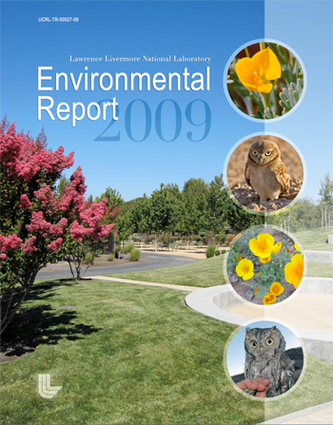Lab's Annual Environmental Report shows no adverse impact to public health or the environment
Environmental monitoring of operations at Lawrence Livermore National Laboratory in 2009 indicates no adverse impact to public health or the environment from Laboratory operations. The findings are presented in the Laboratory's Environmental Report 2009.
The annual report demonstrates LLNL's continuing commitment to providing responsible stewardship of the environmental resources in its care and the integration of environmental stewardship into strategic planning and decision-making processes through the Lab's Environmental Management System.
The report summarizes the Lab's regulatory compliance with environmental standards and requirements, describes LLNL's environmental protection and remediation programs, and presents the results of environmental monitoring for the main Laboratory site and Site 300, the Laboratory's experimental test facility near Tracy, Calif. Monitoring samples were taken from air, water, vegetation, foodstuff, soil and wastewater on site and in surrounding communities. LLNL's environmental releases are highly regulated.
In addition, the report documents the substantial actions the Laboratory has taken to comply with federal, state and local environmental laws, including the Clean Air Act, Clean Water Act, Resource Conservation and Recovery Act, and National Environmental Policy Act, among others.
The following is a summary of findings in Lawrence Livermore National Laboratory's Environmental Report 2009. The complete report may be accessed on the Website. It also is available in the environmental repositories of the Livermore and Tracy public libraries.
- Pollution prevention -- In 2009, the Laboratory received the California Integrated Waste Management Board's 2009 WRAP award. This is the second consecutive year that LLNL has received this award. The award recognizes California businesses and organizations that have made outstanding efforts to reduce nonhazardous waste by implementing resource-efficient practices, aggressive waste reduction, reuse and recycling activities, and procurement of recycled-content products. The Lab also received two Environmental Stewardship awards from the National Nuclear Security Administration for exemplary performance in integrating environmental stewardship practices to reduce risk, protect national resources and enhance site operation.
- Air monitoring -- Air at the Laboratory and throughout the Livermore Valley and in the Tracy area is monitored by some 65 instruments at 38 separate locations. In 2009, radionuclide and beryllium concentrations in air were well below the levels that would cause concern for the environment or public health.
- Water monitoring/groundwater remediation -- Data indicate LLNL has good control of its discharges to the sanitary sewer, and discharges to surface water and groundwater do not have any apparent environmental impact. At both the Livermore site and at Site 300 remediation activities continued to meet regulatory milestones, removing contaminants from groundwater and soil vapor that resulted from past operations.
- Terrestrial radiological monitoring -- The impact of LLNL operations on surface soil in 2009 was insignificant. Vegetation and Livermore Valley wine were sampled for tritium, and the concentrations in most off-site vegetation samples were below the lower limit of detection. For Livermore Valley wines purchased in 2009, the highest concentration of tritium was just 0.77 percent of the EPA's standard for maximal permissible level of tritium in drinking water.
- Biota -- The Laboratory meets the requirements of federal and state regulatory acts covering endangered or sensitive natural resources. The Laboratory studies, preserves and attempts to improve the habitat of five animal and plant species at Site 300 that are covered by the federal or California Endangered Species Acts, as well as species that are rare and otherwise of special interest. The 2009 radiological doses calculated for biota at the Lab's main site and at Site 300 were far below screening limits set by the Department of Energy.
- Radiological dose - Annual radiological doses at the Livermore site and at Site 300 in 2009 were found to be well below the applicable standards for radiation protection of the public. Two methods are used to assess radiological dose. One assesses maximum dose to a hypothetical person living for a year, 24 hours a day, in a location near the Lab where that person would receive the highest possible radiation dose through the air. The other method assesses collective dose to the population living within 80 kilometers of the Laboratory. The maximum radiological doses that could have been received by individual members of the public from releases to the air from Livermore site and Site 300 operations in 2009 were just 0.042 percent and 0.0000027 percent of the federal limit, respectively -- more than 8,000 times smaller and 100 million times smaller, respectively, than the dose members of the public receive annually from natural background radiation. The collective doses from LLNL operations in 2009 were more than 750,000 times smaller than those caused by natural radioactivity in the environment.
Contact
Gordon Y Yano[email protected]
Related Links
LLNL Site Annual ReportLLNL Environmental Community Relations





